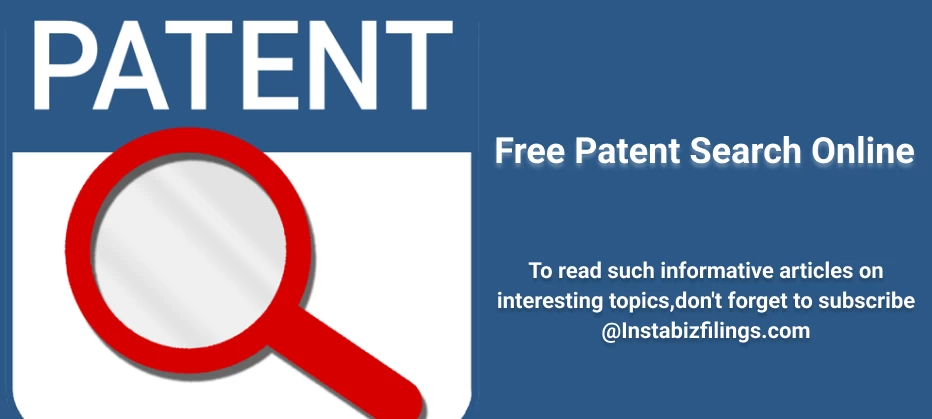
Free Patent Search Online
October 16, 2025 by Team Instabizfilings
What is a Patent Search & Why It Matters
A patent search is the process of checking existing patent literature to find prior art that is similar to your invention. It helps you understand:
-
Whether your invention is novel/non‐obvious (key criteria for patentability)
-
What scope competitors may already have claimed
-
Whether it’s worth investing in preparing a patent application
-
How to draft claims to avoid overlap with existing patents
-
If your product or idea might infringe on someone else’s patent / “Freedom to Operate” concerns
Doing a thorough search early can save time, money, and reduce risk of rejection or legal issues later.
Key Components of a Patent Search
When you perform a patent search, you usually look at:
-
Title / Abstract / Claims : gives a summary of what’s claimed.
-
Full Text / Description / Drawings : to understand the scope and detailed technical disclosure.
-
Publication Date / Filing Date : important for priority.
-
Patent Classification Codes : IPC, CPC, etc., to narrow search by technology class.
-
Legal Status : whether a patent is granted, expired, or pending.
-
Jurisdiction : patents in different countries; sometimes you want a global search.
-
Inventor / Applicant / Assignee & Family : to track similar inventions or related patents.
What’s “Free” vs “Paid” in Patent Search
Free patent databases let you access patent documents and do basic searches without cost. They usually provide:
-
Bibliographic data (title, inventor, applicant, dates)
-
Abstracts/summaries
-
Sometimes full text of the description & drawings
-
Search by keywords, classification codes, application/publication numbers, and applicant name
Limitations of free tools:
-
May not show legal status or enforcement info reliably in all jurisdictions
-
Might lag in updates for some national patent offices
-
Less smooth user experience, fewer advanced analytics or filtering features
-
No professional search report/expert analysis (for example novelty opinions)
Paid services add value: deeper analytics, legal opinions, claim-charts, more complete & accurate coverage, FTO risk assessments, monitoring, etc.
Key Free Patent Search Tools in 2025
Here are the top free patent databases and tools, with updated details (2025) and what they offer:
|
Tool / Database |
Coverage & Features |
Best For / Unique Features |
|
PATENTSCOPE (WIPO) |
Global / PCT applications, published works from many national offices. Multilingual support, full-text where available. Search by IPC/CPC, chemical structure, and non-patent literature. |
Good for international prior art and early identification of what’s out there globally. Chemical & compound search is especially strong. |
|
USPTO Patent Search |
U.S. granted patents and published applications; legal status in the U.S.; various search tools on the USPTO site. |
Essential if you want U.S. patent coverage; key for inventors targeting the U.S. market. |
|
Espacenet (EPO) |
Huge collection of European & global patent documents; excellent interface, filtering, classification etc. (EPO’s service). |
Great for European / global patent prior arts; strong classification search & cross-jurisdiction exploration. |
|
InPASS (India) |
Indian Patent Advanced Search System (InPASS) published Indian patent applications & granted patents; allows search by keywords, IPC, inventor/applicant etc. |
For inventions in India, check what prior art exists domestically. Important before filing to the Indian Patent Office. |
|
IPTeL / Lens / Google Patents etc. |
Aggregators combining many jurisdictions; good user interfaces; often includes non-patent literature too. |
Quick checks, exploratory search, or when you just want a broad overview. |
|
China National IP Office’s PSS / CNIPA |
Data from China and other countries, legal status, patent families etc. |
If you're interested in inventions or competition in China. |
How to Do a Good Free Patent Search Step-by-Step Guide
Here’s how I’d recommend you do a thorough, effective search using free tools:
-
Define your invention clearly. What are the key features, what differentiates it, what problem it solves?
-
List keywords & synonyms. Include technical terms, common names, and alternate spellings. Also list classification codes (IPC, CPC).
-
Start with a broad keyword search + classification filter. Use WIPO PATENTSCOPE, Espacenet, InPASS etc. to get a rough idea.
-
Narrow results using IPC/CPC codes and Boolean logic. E.g., use “AND”, “NOT”, “OR” operators to refine.
-
Check similar inventions/competitors. Search by applicant/inventor names.
-
Inspect full-text description/claims. Once you find similar patents, read claims & examples carefully to see if your invention is novel or overlaps.
-
Verify legal status. Is the patent active, expired, lapsed, rejected etc.? That matters a lot.
-
Track patent families. Keep track of corresponding filings in other jurisdictions for similar inventions (often found via WIPO / Espacenet).
-
Document your search. Save patent numbers, abstracts, and what classifications were useful — useful for drafting your patent application later, or for future proof of due diligence.
Specific Updates / Features in 2025
-
PATENTSCOPE now supports cross-lingual semantic search and chemical structure (SMILES, InChI etc.) search.
-
Global Dossier on USPTO / EPO / WIPO allows you to view prosecution history and cited references; great for understanding allowed scope.
-
Many tools have export/visualisation features: filters by date, applicant, inventor; graphs/timelines in PATENTSCOPE.
Limitations & What Free Search Often Doesn’t Cover
-
Unpublished patent applications (still in secret or pending) are generally not searchable until publication.
-
“Patent pending” strategies may not show in all offices immediately.
-
Legal status updates may lag, especially for smaller jurisdictions.
-
No guarantee you find all relevant prior art — non-patent literature (journals, academic papers, technical reports) often not fully captured.
-
Free tools usually lack expert judgment — whether something is obvious or novel often requires technical and legal interpretation.
Practical Tips & Best Practices
-
Use multiple databases — U.S., Europe, WIPO, India etc., depending on where you plan to file or compete.
-
Use classification codes early — helps reduce noise. For example, IPC/CPC codes.
-
Save all search queries & results in case needed later in prosecution or litigation.
-
Monitor “similar inventions” regularly — inventions evolve; doing another search later (before filing) helps.
-
Collaborate with patent professionals when nearing filing — they can find “hidden” prior art and advise on claim scope.
Example Workflow: India-Focused Search
Imagine you have an idea for a new mechanism in agricultural machinery.
-
Go to InPASS (Indian Patent Advanced Search System). Search by keyword “automatic seed planter” + IPC code (e.g., A01C / B05B etc.).
-
Read abstracts & title of search results; filter by granted vs published applications.
-
Go to PATENTSCOPE and search for similar keywords globally; also check “seed planter agricultural device” + similar classification.
-
Use Espacenet for European patents or those filed in EPO jurisdictions. Export a few that seem very similar.
-
Check U.S. patents via USPTO searches if you plan to file in the U.S.
Disclaimer
The information provided in this blog is purely for general informational purposes only. While every effort has been made to ensure the accuracy, reliability and completeness of the content presented, we make no representations or warranties of any kind, express or implied, for the same.
We expressly disclaim any and all liability for any loss, damage or injury arising from or in connection with the use of or reliance on this information. This includes, but is not limited to, any direct, indirect, incidental, consequential or punitive damage.
Further, we reserve the right to make changes to the content at any time without prior notice. For specific advice tailored to your situation, we request you to get in touch with us.


